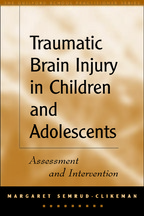Traumatic Brain Injury in Children and Adolescents
Assessment and Intervention
Margaret Semrud-Clikeman
Hardcover
Hardcover
orderAugust 1, 2001
ISBN 9781572306868
Price: $49.00 211 Pages
Size: 6" x 9"
Professors: request an exam copy
The return to school following traumatic brain injury (TBI) is fraught with challenges for children and adolescents, their families, and school professionals. This volume provides the practical knowledge needed to understand the neuropsychological problems associated with TBI and facilitate students' reintegration into the regular or special education classroom. Research-based strategies are presented for assessing and accommodating each student's needs, with suggestions for testing that can be completed by practitioners without extensive neuropsychological training. Featuring numerous illustrative clinical examples, the book also includes an extended case history that brings to life the entire process of recovery from TBI.
Reviewing basic neuroanatomy, the book first discusses the functional problems and areas of learning difficulty that typically arise from different types of injury. It explores the associated emotional challenges and issues facing families, emphasizing the importance of working closely with parents and building effective home-school partnerships. Identified and briefly described are over 30 psychological measures that can be used to evaluate cognitive and academic skills; memory and learning; attention; executive and reasoning skills; visual-motor and perceptual skills; and psychosocial, emotional, and behavioral functioning. Detailed sample assessments are provided for two students with injuries of varying severity, showing how test results and other information can be integrated into a useful comprehensive report. Guidelines are then presented for managing school reentry and conducting team-based planning and decision making. General programming considerations are discussed, as are specific interventions that incorporate knowledge from the fields of ADHD, learning disabilities, and adult rehabilitation.
Written in a clear, non-technical style, this book is an essential resource for school psychologists, counselors, and social workers; special education professionals; and other clinicians working with young people. It will also serve as a text in graduate-level neuropsychological assessment courses.
Reviewing basic neuroanatomy, the book first discusses the functional problems and areas of learning difficulty that typically arise from different types of injury. It explores the associated emotional challenges and issues facing families, emphasizing the importance of working closely with parents and building effective home-school partnerships. Identified and briefly described are over 30 psychological measures that can be used to evaluate cognitive and academic skills; memory and learning; attention; executive and reasoning skills; visual-motor and perceptual skills; and psychosocial, emotional, and behavioral functioning. Detailed sample assessments are provided for two students with injuries of varying severity, showing how test results and other information can be integrated into a useful comprehensive report. Guidelines are then presented for managing school reentry and conducting team-based planning and decision making. General programming considerations are discussed, as are specific interventions that incorporate knowledge from the fields of ADHD, learning disabilities, and adult rehabilitation.
Written in a clear, non-technical style, this book is an essential resource for school psychologists, counselors, and social workers; special education professionals; and other clinicians working with young people. It will also serve as a text in graduate-level neuropsychological assessment courses.
“This fine volume should be on the shelf of all neuropsychologists who see children, as well as child clinical psychologists and school psychologists. There is a wealth of instructive and practical information in this well-written and accessible book that has not been covered in this depth in any other work.”
—Nancy Nussbaum, PhD, Pediatric Neuropsychologist, Austin Neurological Clinic, Austin, Texas
“As an attorney specializing in medical malpractice cases that focus on pediatric brain injury, I review and evaluate traumatic brain injury cases on a daily basis. This book offers an excellent introduction to the leading edge of research, evaluation, and treatment in this complex area. It provides readers not only with the neuroanatomical knowledge needed to understand the clinical implications of brain injury, but also with the tools to assess the profound impact of this injury on the individual, family, and educational system. Comprehensive, intelligent, and readable.”
—Mark R. Mueller, JD, Mueller Law Offices, Austin, TX
“This book offers a thorough yet concise introduction to childhood traumatic brain injury. The breadth of content makes it an ideal resource for school practitioners involved in assessment and consultation. Even experienced practitioners will find useful information to guide their work with this population. In addition, students in graduate-level general neuropsychology courses will find it a valuable supplementary text.”
—Mike Havey, EdD, Coordinator, School Psychology Program, Department of Psychology, Eastern Illinois University, Charleston, IL
Table of Contents
1. Introduction2. Functional Neuroanatomy
3. Neuropsychological Correlates
4. Family Influences on Children and Adolescents
5. Neuropsychological Assessment
6. Two Assessment Examples
7. Promoting Reentry into the School Setting
8. Classroom Interventions
9. Case Illustration
10. Parting Thoughts
Glossary
Appendices
References
Index
About the Author
Margaret Semrud-Clikeman, PhD, is Associate Professor of Educational Psychology at the University of Texas at Austin. She received her master's degree from the University of Wisconsin–Madison and her doctorate from the University of Georgia. Dr. Semrud-Clikeman was a school psychologist in Wisconsin for 13 years prior to beginning her doctoral education. She completed a neuroscience fellowship at Massachusetts General Hospital/McLean Hospital/Harvard Medical School and received the early career award from the National Academy of Neuropsychology in 1999 for her contributions in clinical neuropsychology. Dr. Semrud-Clikeman's current interests include the neuroanatomical and neuropsychological underpinnings of attention-deficit/hyperactivity disorder and developmental disorders, interventions, and issues in the training of school psychologists.Audience
School psychologists, counselors, and social workers; special education professionals; neuropsychologists and other clinicians working with children.Serves as a text in graduate-level courses on neuropsychological assessment
